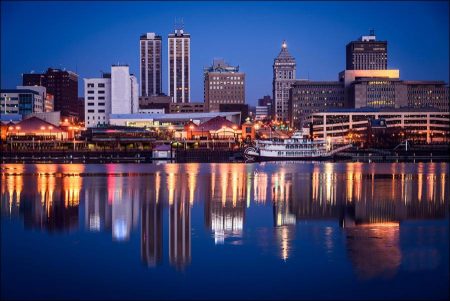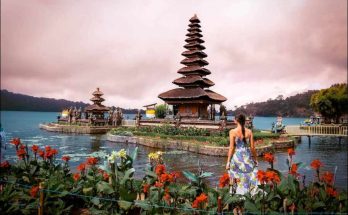Peoria (608 alt., 112,936 pop.), named for an Indian tribe, is the seat of Peoria County and Illinois’ second largest city. The Peoria Metropolitan Statistical Area had a population of 369,161 in 2005. Slightly north and west of the center of the State, the city lies on three levels along the northwest bank of the Illinois River, where it widens into a broad basin known as Lake Peoria. The river has been a notable factor in both the early settlement and the present industrial prominence of Peoria.
On the river’s narrow alluvial plain are many of Peoria’s major industrial plants, grouped there partly because of their early dependence on water power, but largely to make use of cheap water transportation. A river and rail terminal maintained by the city serves as a ligature between its 14 railroads and the barge lines that connect upstream with Chicago, by way of the Sanitary and Ship Canal, and downstream with the Gulf of Mexico, along the Mississippi.
Paralleling the band of industrial establishments in the lowlands is a second bench, higher and wider, anciently the river’s bed. On it lie the business district and an extensive residential section. This level runs back from one to two miles to the Bluffs, the earliest bank of the river. From the Bluffs residential Peoria commands a view of the clustered business district, the serrated line of mills and factories along the curving river, and, far beyond the industrial suburbs, the checkered farm fields. Grand View Drive and the Galena Road, both branching from the end of Adams Street at the entrance to Grand View Park, offer fine views of the region.
From neighboring fields and from countless more throughout the Corn Belt, Peoria’s four distilleries draw a considerable portion of the corn crop. With five rectifying plants, the distilleries produce a greater volume of spirituous liquors than any other city in the United States, and together yield $50,000,000 annually to the Internal Revenue Department. Because of Peoria’s supply of pure water and its nearness to corn and coal, it has been a distilling center since the middle of the nineteenth century.
The first white men to reach this site were Father Marquette and the explorer, Jolliet, who passed through Lake Peoria in the fall of 1673, returning from their exploratory trip down the Mississippi. In his Recite Marquette mentions meeting the Indians “of Peourea,” but this encounter did not occur here. The expedition erected no buildings, but the teachings of Marquette and his promise of the French king’s protection against the Iroquois warriors from the north established mutual friendliness and confidence. But early quarrels among the French, Jesuits on the one side and imperialists on the other, later conflicts between the French and English, and finally the war between the American Colonists and the English, shifted protection of the tribes from group to group until they lost all confidence in the “Great White Father,” whose identity was always changing.
Marquette did not return, but in 1680 Robert Cavelier, Sieur de La Salle, with Henri de Tonti, Père Louis Hennepin, a group of Recollect friars and artisans, about 33 men in all, descended the Illinois River to Lake Peoria. At the outlet of the lake, on the left bank of the river, they erected Fort Crèvecoeur, “the refuge of the broken heart.” Despite romantic legends to the contrary, the fort was probably so named to commemorate the then recent French capture of Fort Crèvecoeur in the Netherlands. Its name, however, foreshadowed its history, for within three months it was plundered and abandoned by its forces during La Salle’s absence.
In 1691 Fort St. Louis, upstream from Peoria on Starved Rock, was abandoned, and the post moved to Lake Peoria, where it was usually referred to as Fort Pimiteoui (Ind., fat lake). On the settlement that grew up about it, Peoria bases its claim to being the oldest city in Illinois against the claim of Cahokia, founded in 1699. Settlement at this spot was not continuous after 1691, but certainly this was the first Illinois settlement on a site that is occupied today.
Center of a large tribe of friendly Indians, and possessing excellent transportation to key French settlements, the trading post thrived, and soon was ranked among the most important in this new country. In 1763 the British wrested control of the area from the French, but the treaty which concluded the French and Indian War exerted little influence here. Although the settlement was virtually abandoned during the Revolutionary War, the French returned, took up residence at a new village on the right bank of the river, and continued their trading well into the period of American jurisdiction. Historically unique among Illinois towns, the village at Peoria Lake was visited by two military expeditions during the Revolutionary War.
The first, a group of George Rogers Clark’s men, destroyed the Indian village here. In 1781 a company of Spaniards, French, and Indians came up the Illinois river to Peoria Lake, and from here crossed by land to the British post of St. Joseph, in Michigan, which they captured without a battle.
The new village to which the French returned was variously referred to as Au Pé, Le Pé, Opa, and Au Pay, and as early as 1790 there is reference to it as Piorias–the “s” was not pronounced–but it is not known when that name achieved common usage.
During the War of 1812 a military blunder on the part of the American forces resulted in the partial destruction of Au Pé. Alarmed at the depredations of the Indians, Governor Ninian Edwards led troops up from Edwardsville and destroyed the village of Black Partridge, unaware that the chief was rendering assistance in the attempt to recover Americans kidnapped at the Fort Dearborn massacre. Shortly afterward, another part of the same force, under Capt. Thomas Craig of Shawneetown, destroyed a large part of the French village and carried off its inhabitants. Subsequently the friendliness-or at least the neutrality–of the French was proved, and they were released.
On the site of Au Pé late in 1813 the Americans erected Fort Clark, and about it grew up the nucleus of modern Peoria, although the name of Fort Clark clung to it for more than 10 years. In 1819 the first American civilians arrived, a party of seven, forerunners of the swarm of land-seekers soon to follow. The river that had borne French traders and their cargoes for more than a century now helped bring in the tide of “movers,” of New England farmers eager for cheap rich land, and the smattering of professional men who followed the first contingent of ground-breakers.
In 1825 Peoria County was created, and the community of Fort Clark, with the French-Indian name of Peoria officially restored, was designated county seat. Although Putnam County was laid out at the same time, comprising almost all of Illinois north of Peoria, no governmental machinery was set up for that county and business was transacted at Peoria. From here, for a period of six years, jurisdiction was exercised over one-fourth of Illinois, including the stripling village of Chicago.
Largely because of the broad river at its door, Peoria had almost a decade’s lead in appreciable settlement over other large cities in North Central Illinois, antedating Galesburg and Bloomington. When the first steamboat came up the Illinois about 1828, it found a sizeable cluster of cabins at the lake. In 1835, when Peoria was incorporated as a town, it had a population of more than 500. A decade later it had grown to 2,000, and by 1845 had adopted a city charter.
In 1854 the bustling young village was the scene of a highly important event in the career of Lincoln. On October 16, after Stephen Douglas had spoken all afternoon, Lincoln rose and requested that the crowd return after supper to hear his rebuttal. That evening he addressed to them a longer version of a speech he had given 12 days earlier at Springfield. Concerning the speech, Albert Beveridge says, in his Abraham Lincoln, “Thus did Lincoln, for the first time in his life, publicly and in forthright words denounce slavery, and assert that it was incompatible with American institutions.” The speech was not one of the series known as the Lincoln-Douglas Debates, which it antedated by four years.
Pork packing was one of the earliest industries; beef packing came later, and both are still carried on. In the 1840’s began the first stirrings of the intense industrialization that quadrupled the population between 1850 and 1870. Early entering the profitable industry of farm implement manufacture, Peoria was making plows, threshing machines, and fanning mills by 1844.
By 1860 the city had seven distilleries, with a capital investment of $700,000. At first highly competitive, the distilleries became part of the Cattle Feeders’ and Distillers’ Trust–the “Whiskey Trust”–organized by Joseph Greenhut of Peoria in the 1880’s. Small distilleries were closed, and the trade was concentrated at 12 large plants, 6 of which were in Peoria.
So effective was this combine that between 1870 and 1890 the number of distilleries in Illinois declined from 45 to 7, while the average output rose in value from $175,300 to $7,448,000 annually. The organization continued in existence until the early 1900’s, when the wave of “trust-busting” effected its dissolution.
Visits: 165



